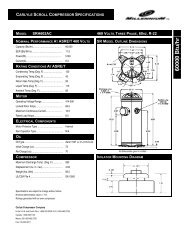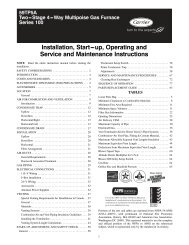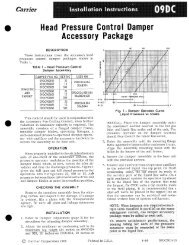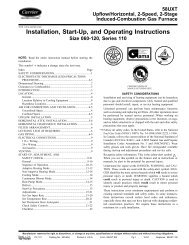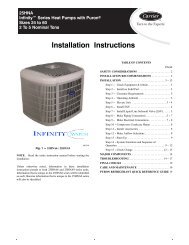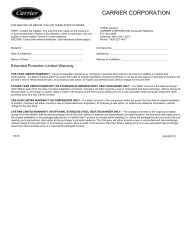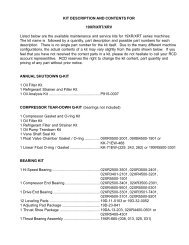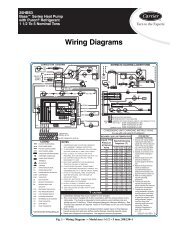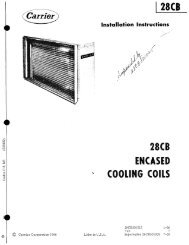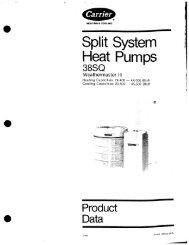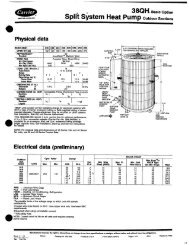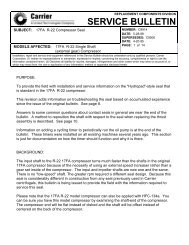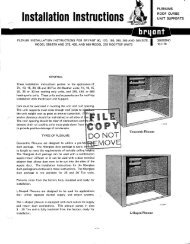Table 10 — ComfortLink Display Menu StructureMODESETPOINTS INPUTS OUTPUTS CONFIGURATION TIMECLOCKRUNSTATUSAutoDisplay(VIEW)SERVICETESTManualTestMode(TEST)QuickTestMode(QUIC)TEMPERATURESPRESSURESOPERATINGMODESOperatingControlType(SLCT)OperatingModes(MODE)ALARMSUnitTemperatures(UNIT)Circuit APressures(PRC.A)CoolingSetpoints(COOL)GeneralInputs(GEN.I)Circuit AOutputs(CIR.A)DisplayConfiguration(DISP)Time of Day(TIME)ResetCurrentAlarms(R.ALM)CurrentAlarms(ALRM)RemoteUserInterface(R.CCN)Machine<strong>Start</strong>s/Hours(RUN)CompressorRun Hours(HOUR)Compressor<strong>Start</strong>s(STRT)Circuit ATemperatures(CIR.A)Circuit BPressures(PRC.B)HeatingSetpoints(HEAT)Circuit BOutputs(CIR.B)UnitConfiguration(UNIT)Day, Date(DATE)Circuit BTemperatures(CIR.B)Circuit CPressures(PRC.C)Misc.Setpoints(MISC)Circuit COutputs(CIR.C)<strong>Service</strong>Configurations(SERV)Schedule 1(SCH1)AlarmHistory(H.ALM)Circuit CTemperatures(CIR.C)GeneralOutputs(GEN.O)OptionsConfiguration(OPTN)Reset,Demand Limit,Master/Slave(RSET)Schedule 2(SCH2)Holidays(HOLI)Fan RunHours(FAN)<strong>Service</strong>MaintenanceConfiguration(MCFG)CompressorDisable(CP.UN)PredictiveMaintenance(MAIN)SoftwareVersions(VERS)Local Equipment Network — Information is transmittedbetween modules via a 3-wire communication bus orLEN (Local Equipment Network). External connection to theLEN bus is made at TB3.Board Addresses — All boards (except the main baseboard and the energy management module) have 8-positionDIP switches. Addresses for all boards are listed with the Input/Output Tables for each board.Control Module CommunicationRED LED — Proper operation of the control boards can bevisually checked by looking at the red status LEDs (lightemittingdiodes). When operating correctly, the red statusLEDs will blink in unison at a rate of once every 2 seconds. Ifthe red LEDs are not blink in unison, verify that correct poweris being supplied to all modules. Be sure that the main baseboard (MBB) is supplied with the current software. If necessary,reload current software. If the problem still persists,replace the MBB. A red LED that is lit continuously or blinkingat a rate of once per second or faster indicates that the boardshould be replaced.GREEN LED — All boards have a green LEN (SIO) LEDwhich should be blinking whenever power is on. If the LEDsare not blinking as described check LEN connections forpotential communication errors at the board connectors. SeeInput/Output Tables for LEN connector designations. A 3-wirebus accomplishes communication between modules. These3 wires run in parallel from module to module. The J9A connectoron the MBB provides communication directly to thescrolling marquee display or the Navigator display module.YELLOW LED — The MBB has one yellow LED. The<strong>Carrier</strong> Comfort Network ® (CCN) LED will blink during timesof network communication.<strong>Carrier</strong> Comfort Network (CCN) Interface — All30RB units can be connected to the CCN, if desired. The communicationbus wiring is a shielded, 3-conductor cable withdrain wire and is field supplied and installed. The system elementsare connected to the communication bus in a daisy chainarrangement. The positive pin of each system element communicationconnector must be wired to the positive pins of thesystem elements on either side of it, that is also required for thenegative and signal ground pins of each system element. Wiringconnections for CCN should be made at TB3. Consult theCCN Contractor’s Manual for further information. See Fig. 10.NOTE: Conductors and drain wire must be 20 AWG (AmericanWire Gage) minimum stranded, tinned copper. Individualconductors must be insulated with PVC, PVC/nylon, vinyl,Teflon, or polyethylene. An aluminum/polyester 100% foilshield and an outer jacket of PVC, PVC/nylon, chrome vinyl,or Teflon with a minimum operating temperature range of–20 C to 60 C is required. See Table 11 for recommended wiremanufacturers and part numbers.Fig. 10 — ComfortLink CCN Communication Wiring16
Table 11 — CCN Communication Bus WiringMANUFACTURERPART NUMBERRegular Wiring Plenum WiringAlpha 1895 —American A21451 A48301Belden 8205 884421Columbia D6451 —Manhattan M13402 M64430Quabik 6130 —It is important when connecting to a CCN communicationbus that a color-coding scheme be used for the entire networkto simplify the installation. It is recommended that red be usedfor the signal positive, black for the signal negative, and whitefor the signal ground. Use a similar scheme for cables containingdifferent colored wires.At each system element, the shields of its communicationbus cables must be tied together. If the communication bus isentirely within one building, the resulting continuous shieldmust be connected to a ground at one point only. If the communicationbus cable exits from one building and enters another,the shields must be connected to grounds at the lightningsuppressor in each building where the cable enters or exits thebuilding (one point per building only). To connect the unit tothe network:1. Turn off power to the control box.2. Cut the CCN wire and strip the ends of the red (+), white(ground), and black (–) conductors. (Substitute appropriatecolors for different colored cables.)3. Connect the red wire to (+) terminal on TB3 of the plug,the white wire to COM terminal, and the black wire to the(–) terminal.4. The RJ14 CCN connector on TB3 can also be used, but isonly intended for temporary connection (for example, alaptop computer running <strong>Service</strong> Tool).IMPORTANT: A shorted CCN bus cable will preventsome routines from running and may prevent the unitfrom starting. If abnormal conditions occur, disconnectthe CCN bus. If conditions return to normal,check the CCN connector and cable. Run new cable ifnecessary. A short in one section of the bus can causeproblems with all system elements on the bus.Configuration OptionsMINIMUM LOAD CONTROL (Configuration→UNIT→HGBP) reduces the capacity of the 30RB chiller below thelowest standard capacity step by use of hot gas bypass. Thiscapacity step reduction provides more precise control of theleaving water temperature.Minimum Load Control can be configured in three differentways. If Minimum Load Control is not used, HGBP must beset 0. If HGBP is set to 1, the control will activate the minimumload control valve when the machine is started only. Thiswill be the first step of capacity. If HGBP is set to 2, all stagesof capacity can utilize the minimum load control valve. IfHGBP is set to 3, the minimum load control valve will be usedonly when the circuit has a high pressure override active. Thiswill reduce the capacity of the circuit.RAMP LOADING (Configuration→OPTN→RL.S), limitsthe rate of change of leaving fluid temperature. If the unit is ina Cooling mode and configured for Ramp Loading, the controlmakes 2 comparisons before deciding to change stages ofcapacity. The control calculates a temperature differencebetween the control point and leaving fluid temperature. If thedifference is greater than 4° F (2.2° C) and the rate of change(°F or °C per minute) is more than the configured Cool RampLoading (Setpoints→COOL→CRMP), the control does notallow any changes to the current stage of capacity.MINUTES OFF TIME (Configuration→OPTN→ DELY) isa time delay added to the start when the machine is commandedON. This is a field configurable item from 1 to15 minutes. The factory default is 1 minute. This feature isuseful when multiple units are installed. Staggering the startwill reduce the inrush potential.Dual Chiller Control — The dual chiller routine isavailable for the control of two parallel units supplying chilledfluid on a common loop. This control is designed for a parallelfluid flow arrangement only. One chiller must be configured asthe master chiller, the other as the slave chiller. An additionalleaving fluid temperature thermistor (Dual Chiller LWT) mustbe installed in the common chilled water piping as described inthe Installation Instructions for both the master and slavechillers. See the Field Wiring section in the 30RB InstallationInstructions for dual chiller LWT sensor control wiring. Achilled water flow switch is factory-installed for each chiller.Parallel chiller control with dedicated pumps is recommended.Chiller must start and stop its own water pump locatedon its own piping. If pumps are not dedicated for eachchiller, chiller isolation valves are required: each chiller mustopen and close its own isolation valve through the control(valve shall be connected to the pump outputs). Pump Controlis enabled as described in the Cooler Pump Control section onpage 31. One additional parameter is set for the dual chillercontrol. Lag Unit Pump Select, (Configuration→RSET→LAGP) allows the user to configure the control to energizethe pump for the lag chiller once the unit enters an occupiedtime period or delay the control until the lag chiller is started. Itis recommended that this parameter be set to 0, OFF IF UNITSTOPPED.The control of the slave chiller is directed through commandsemitted by the master chiller. The slave chiller has noaction in master/slave operations it shall only verify that CCNcommunication with its master is present. See the Dual ChillerSequence of <strong>Operation</strong> section on page 46.Use dual chiller control to designate a lead chiller betweenthe master and slave chiller. Configure the Lead/Lag BalanceSelect (Configuration→RSET→LLBL) to ENBL to base theselection on the Lead/Lag Balance Delta (Configuration→RSET→LLBD) between the master and slave run hours. Ifthe run hour difference between the master and the slaveremains less than LLBD, the chiller designated as the lead willremain the lead chiller. The Lead/Lag changeover between themaster and the slave chiller due to hour balance will occur duringchiller operating odd days, such as day 1, day 3, and day 5of the month, at 12:00 a.m. If a lead chiller is not designated,the master chiller will always be designated the lead chiller.The dual chiller control algorithm has the ability to delaythe start of the lag chiller in two ways. The Lead PulldownTime (Configuration→RSET→LPUL) provides a field configurabletime delay of 0 to 60 minutes. This time delay givesthe lead chiller a chance to remove the heat that the chilled waterloop picked up while being inactive during an unoccupiedperiod. The Lead Pulldown Time parameter is a one-time timedelay initiated after starting the lead chiller, manually or by aschedule, before checking whether to start an additional chiller.This routine provides the lead chiller an opportunity to pulldown the loop temperature before starting another chiller. Thesecond time delay, Lead/Lag Delay (Configuration→RSET→LLDY) is a time delay imposed between the laststage of the lead chiller and the start of the lag chiller. This preventsenabling the lag chiller until the lead/lag delay timer hasexpired. See Tables 12 and 13.17



